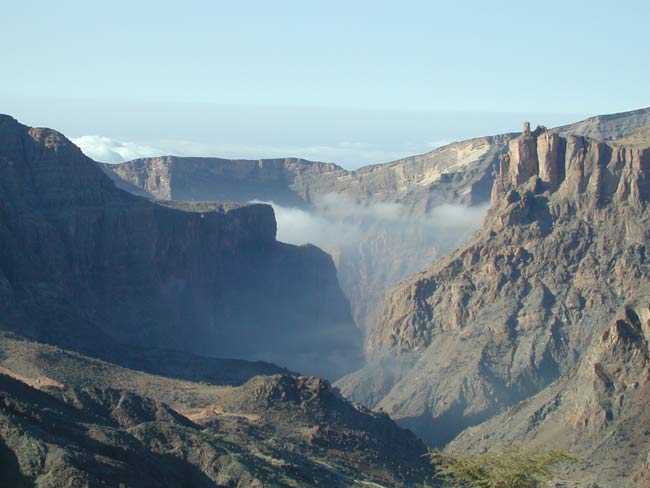Snowball Fight Erupts over Frozen Earth Theory

The theory that the Earth long ago froze completely over, like a giant snowball, is challenged by new data from desert outcroppings in Oman. The geological measurements indicate that even as glaciers spread across all the continents 700 million years ago, warm spells with liquid water were still common. The question now is how did our planet resist becoming a popsicle. "It was Earth's great escape," said geologist Philip Allen of Imperial College London. "The Earth experienced probably the most profound glaciation in its history, but somehow it pulled back from the brink of global catastrophe." That theorized catastrophe has been called Snowball Earth. Climate models show that if large areas of land become covered with ice, more sunlight is reflected away, causing temperatures to drop further. This leads to runaway cooling, in which even the oceans freeze over for millions of years. "It is hard to imagine a more extreme climate event than this," said geochemist Daniel Schrag of Harvard University. Runaway cooling Snow and ice reflect roughly 80 percent of sunlight back into space, while seawater reflects about 10 percent and dry ground somewhere in between the two. This reflected light counts as a loss of potential heat. Climate models predict that if ice sheets stretch from the poles to about 30 degrees latitude (where New Orleans is now), then the reflection will become so great as to cool the planet. A colder Earth makes more ice and reflects away more sunlight in a positive feedback loop. "It's kind of the reverse of the greenhouse effect ," Allen explained. This runaway cooling likely occurred during the Cryogenian period, but how far it went is still not clear. Could it happen again? The Sun has become 6 percent stronger since the Cryogenian, so it should be harder to freeze the Earth now. It's worth noting that ice sheets reached only New England (45 degrees latitude) during the last Ice Age 20,000 years ago, said Schrag. The ice planet cometh Schrag and others have been developing the Snowball Earth theory over the last decade, but the idea is not entirely new. "Over the last 100 years, ideas of a fully glaciated Earth have come and gone," Allen told LiveScience. Allen admits the Snowball Earth researchers have brought together an impressive array of data that attests to widespread glacier activity between 710 and 640 million years ago, in what geologists call the Cryogenian period. Some of these glaciers sprung up near the equator, implying a very cold planet. Indeed, if ice did cover everything, the average global temperature is expected to have dropped to 70 degrees below zero Fahrenheit. Weathering the storm On a Snowball Earth, liquid water would be locked under ice—in some places a half-mile thick. This sealing of the oceans could explain certain geologic features, like iron and carbonate deposits in Cryogenian rocks. But Allen and his colleagues have found evidence that liquid water was still found on the surface during this time. The research team measured the amount of water-induced weathering in sedimentary rocks from Oman. The results, described in the April issue of Geology, indicate that the Cryogenian climate swung several times between warm-wet and dry-cold, which the authors say is inconsistent with a deep freeze. "Although [Snowball Earth] is a great idea, I am convinced it didn't happen," Allen said. Previous work has discovered other problems with the theory, Allen continued. For example, wave ripples in sandstone from the same period could only have formed in the presence of open water. There is also no evidence for the big chill causing any mass extinctions . Ocean-bound microorganisms, which were the dominant life forms back then, "carried on more or less business as usual," Allen said. Snowball fight However, Schrag argued that the fossil record is "terrible" from the Cryogenian period, so scientists don't actually know whether the business of life was disrupted or not. What is more certain is that a major evolutionary event—the appearance of multicellular animals—occurred a few million years after all the ice melted. Schrag doesn't think this was a coincidence. Moreover, he believes that Allen and others have a simplified "cartoon" picture of the Snowball Earth that they use to attack it. "The model is much more dynamic than they assume," Schrag said. It is wrong, according to Schrag, to say that no water would be around during a Snowball Earth. Greenhouse gases emitted by volcanoes would warm the planet enough for puddles to form near the equator, and geothermal vents would create ice-free oases where life could survive. Handle with care? Even though the debate over Snowball Earth will continue, it raises the question of how bad climate change can get. Allen, for one, believes that natural brakes exist to prevent the climate from snowballing out of control. "The Earth is not fragile," Allen said. "It has seen many bizarre climate extremes but always rebuilds itself afterwards." He imagines that some sort of negative feedback mechanism—perhaps provided by primitive life forms—turned on during the Cryogenian period to keep the oceans from freezing. Might there be another negative feedback mechanism to slow down current global warming? "You are either brave or stupid to rely on that," Allen said.
- Top 10 Ways to Destroy Earth
- Timeline: The Frightening Future of Earth
- Early Life Survived 'Snowball Earth'
Sign up for the Live Science daily newsletter now
Get the world’s most fascinating discoveries delivered straight to your inbox.










